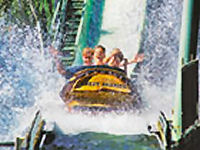

The first log flume ride as we know it today debuted in 1963 at Six Flags Over Texas. “ actually has a strong resemblance to today’s log flumes, with a boat ride through a trough, ending with a lift up a hill, and a splashdown.”Įl Aserradero today. “Later on, in the years following World War I, you started to see what was called a “mill chute” ride, which kind of combined the old mill rides with a Shoot-The-Chutes ride,” says Futrell. The log flume was born out of a sort of hybrid of these early amusements. Another popular boat ride was the mill ride, which was usually just a boat that floated along a trough, through darkened mill-building tunnels. One was a ride known as “Shoot-The-Chutes,” which usually featured a larger passenger boat that would slide down a chute and skip along the water at the bottom before being manually hoisted back up the slope. Meanwhile, as amusement park rides developed and evolved in the early 20th century, boat and chute rides began to spring up, taking their inspiration from the fun-looking logging technology. While it was exceedingly dangerous, it was also a lot of fun. Sometimes these herders would travel down the flumes in custom-built vehicles, but more often than not, they would ride one of the logs down the path. In order to maintain the long system of chutes, and make sure they didn’t become clogged or broken, the owners would employ people known as “flume herders” to inspect the length of the transport channel, looking for potential log jams or broken portions of the flume. (Downside: this devastated the local population of redwood trees, many of which were over 2,000 years old.)

Owned by the King’s River Lumber Company, the massive flume was built in a little over a year, and processed thousands of felled trees. What is thought to have been the longest log flume of all time ran 62 miles between the Sierra Nevada Mountains and a processing site in Sanger, California. Many of the original log flumes could stretch for miles, just like the tracks of a locomotive. This eliminated the need to create roads and bridges for the lumber to be transported overground. Long, usually V-shaped troughs filled with water would carry freshly cut logs over chasms and tough terrain. The first commercial log flumes were built in the mid-1800s by sawmills that used them to transport logs across long distances. Long before the log flume was an amusement park staple, log flumes were used in an industrial setting. “And it also doesn’t drown you.” The log flume is also able to be lightly or heavily themed depending on the park, which gives it a broad business appeal.Ī log flume, the not-fun kind. “The ride has a broad appeal because it has an amount of thrill to it, but it is not overwhelming for little kids and older people,” he says. They might seem quaint, but according to Futrell, it is this simplicity that makes log flumes such fixtures in the amusement park industry. “In the parks that have them, they are always one of the more popular rides,” says Jim Futrell, a historian with the National Amusement Park Historical Association. Not bad for a ride based on a timber transport system. No matter how advanced amusement technology gets, or how death-defying roller coasters become, the simple pleasures of the log ride continue to impress. When you visit, you’re going to see a log flume.

It doesn’t matter whether your amusement park of choice is Disney World or the local local fun park.


 0 kommentar(er)
0 kommentar(er)
